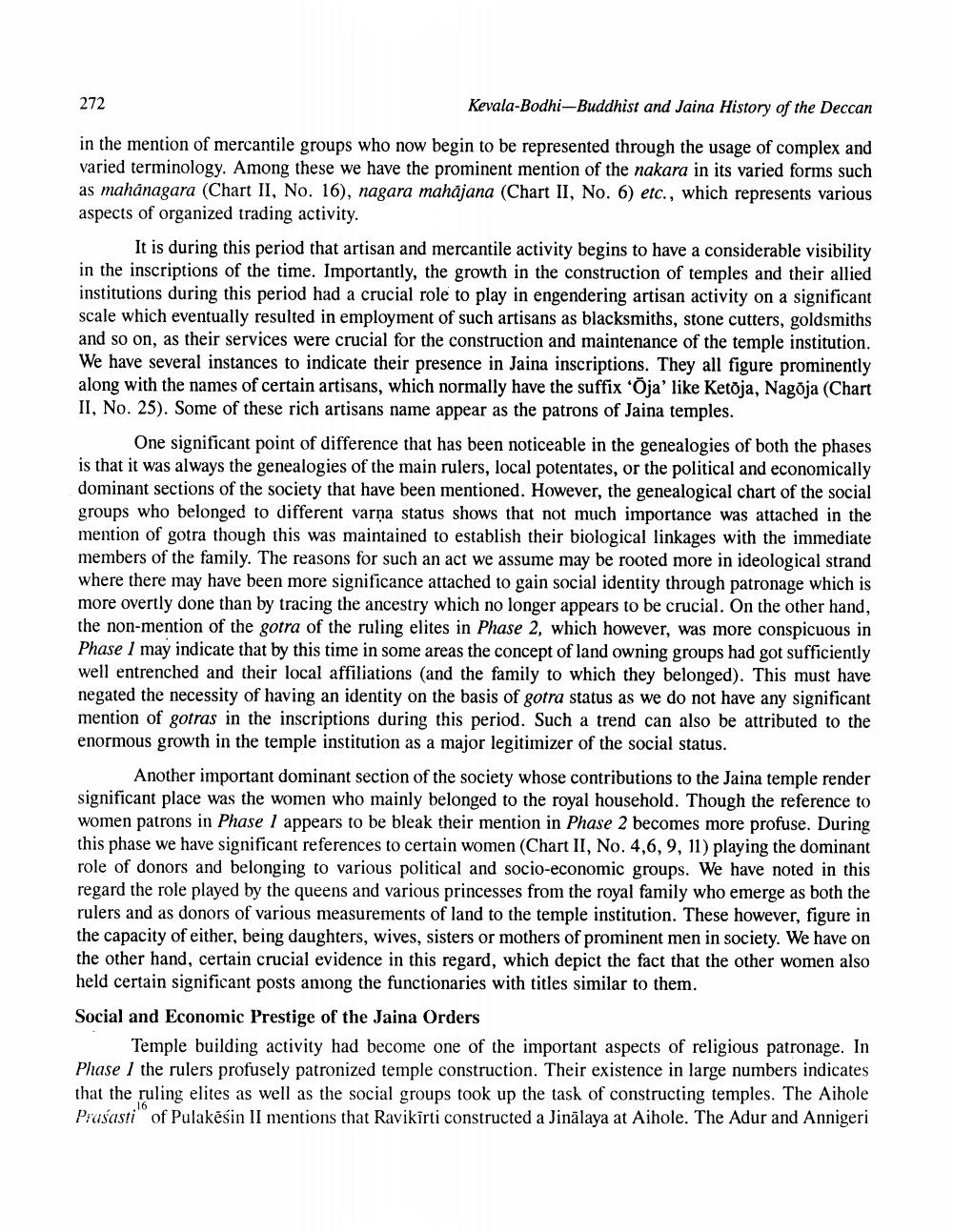________________
272
Kevala-Bodhi-Buddhist and Jaina History of the Deccan
in the mention of mercantile groups who now begin to be represented through the usage of complex and varied terminology. Among these we have the prominent mention of the nakara in its varied forms such as mahanagara (Chart II, No. 16), nagara mahājana (Chart II, No. 6) etc., which represents various aspects of organized trading activity.
It is during this period that artisan and mercantile activity begins to have a considerable visibility in the inscriptions of the time. Importantly, the growth in the construction of temples and their allied institutions during this period had a crucial role to play in engendering artisan activity on a significant scale which eventually resulted in employment of such artisans as blacksmiths, stone cutters, goldsmiths and so on, as their services were crucial for the construction and maintenance of the temple institution. We have several instances to indicate their presence in Jaina inscriptions. They all figure prominently along with the names of certain artisans, which normally have the suffix "Õja' like Ketoja, Nagoja (Chart II, No. 25). Some of these rich artisans name appear as the patrons of Jaina temples.
One significant point of difference that has been noticeable in the genealogies of both the phases is that it was always the genealogies of the main rulers, local potentates, or the political and economically dominant sections of the society that have been mentioned. However, the genealogical chart of the social groups who belonged to different varņa status shows that not much importance was attached in the mention of gotra though this was maintained to establish their biological linkages with the immediate members of the family. The reasons for such an act we assume may be rooted more in ideological strand where there may have been more significance attached to gain social identity through patronage which is more overtly done than by tracing the ancestry which no longer appears to be crucial. On the other hand, the non-mention of the gotra of the ruling elites in Phase 2, which however, was more conspicuous in Phase 1 may indicate that by this time in some areas the concept of land owning groups had got sufficiently well entrenched and their local affiliations (and the family to which they belonged). This must have negated the necessity of having an identity on the basis of gotra status as we do not have any significant mention of gotras in the inscriptions during this period. Such a trend can also be attributed to the enormous growth in the temple institution as a major legitimizer of the social status.
Another important dominant section of the society whose contributions to the Jaina temple render significant place was the women who mainly belonged to the royal household. Though the reference to women patrons in Phase 1 appears to be bleak their mention in Phase 2 becomes more profuse. During this phase we have significant references to certain women (Chart II, No. 4,6,9, 11) playing the dominant role of donors and belonging to various political and socio-economic groups. We have noted in this regard the role played by the queens and various princesses from the royal family who emerge as both the rulers and as donors of various measurements of land to the temple institution. These however, figure in the capacity of either, being daughters, wives, sisters or mothers of prominent men in society. We have on the other hand, certain crucial evidence in this regard, which depict the fact that the other women also held certain significant posts among the functionaries with titles similar to them. Social and Economic Prestige of the Jaina Orders
Temple building activity had become one of the important aspects of religious patronage. In Phase 1 the rulers profusely patronized temple construction. Their existence in large numbers indicates that the ruling elites as well as the social groups took up the task of constructing temples. The Aihole Prasasti" of Pulakėsin II mentions that Ravikirti constructed a Jinālaya at Aihole. The Adur and Annigeri




